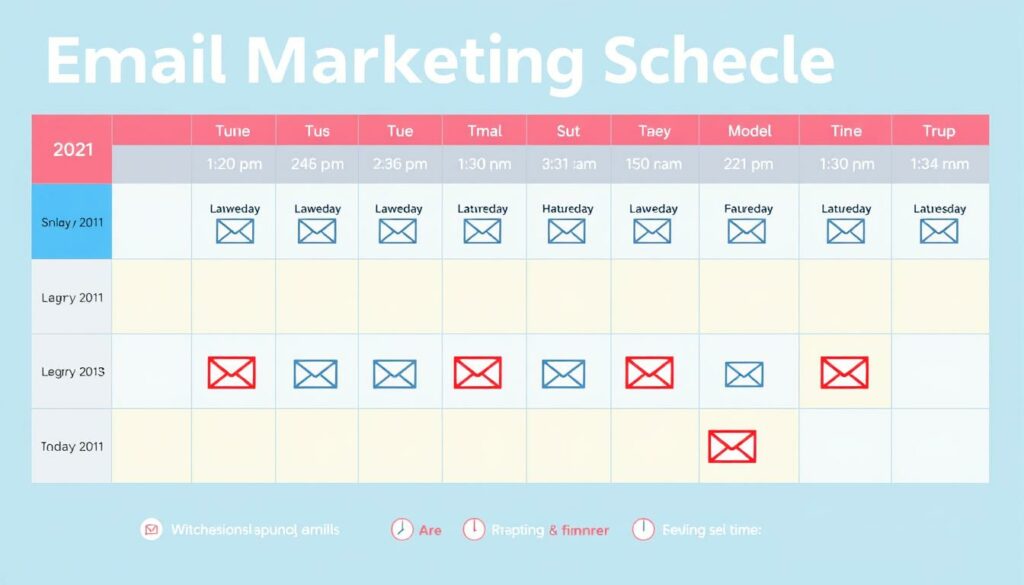As an affiliate marketer, your success depends on connecting with your audience and driving conversions. Email marketing is a key tool, especially for creating high-converting email newsletters. In this guide, we’ll share strategies to boost your affiliate earnings through email newsletters.
Email marketing is crucial for affiliate success, offering a direct way to communicate with your subscribers. It helps build a loyal following. By using email newsletters, you can engage your audience and lead them to profitable affiliate offers, increasing your earnings.
Key Takeaways
- Understand the importance of email marketing for affiliate success
- Learn how to build a loyal subscriber base and engage your audience
- Discover techniques for crafting compelling subject lines and engaging email content
- Optimize your email newsletters for maximum conversions
- Leverage segmentation and personalization to tailor your content
- Analyze key metrics to track and improve your email newsletter performance
- Implement best practices for email newsletter success
The Power of Email Marketing for Affiliates
Email marketing is a key tool for affiliates. It lets you talk directly to your audience and boost sales. The secret to success is using email newsletters to build a loyal base and nurture relationships.
Why Email Newsletters Are Crucial for Affiliate Success
Email newsletters are a big win for affiliates. They help you share valuable content and offers. This turns subscribers into loyal customers who are more likely to buy what you promote.
Building a Loyal Subscriber Base
Having a strong subscriber base is key to affiliate email marketing success. Focus on email list building to attract and keep interested subscribers. Give away valuable freebies and create enticing lead magnets. Deliver top-notch, personalized content to keep your subscribers coming back.
| Benefits of Email Newsletters for Affiliates | Key Metrics to Track |
|---|---|
|
|
“Email newsletters are a powerful tool for affiliates to build relationships, engage their audience, and drive sales for their affiliate products.”
Crafting Compelling Subject Lines
Your subject line is key in email marketing. It’s the first thing people see in their inbox. A good subject line can make your newsletter a hit, boosting open rates and engagement.
There are ways to make your subject lines stand out. This can grab your audience’s attention and improve your email open rates.
Personalize Subject Lines
Using the recipient’s name or other details in your subject line can make a big difference. Studies show it can increase open rates by up to 26%. Personalization makes your emails more engaging and relevant.
Leverage Emojis Strategically
Emojis can add fun and personality to your subject lines. They can make your emails stand out in a crowded inbox. But, use them wisely to avoid looking spammy.
Create a Sense of Urgency
Subject lines that create a sense of urgency can work well. Words like “Limited time” or “Act now” can encourage people to open your email. Just make sure your claims are true to keep your audience’s trust.
| Subject Line | Open Rate |
|---|---|
| Increase your email open rates by 26% with this one simple trick | 32% |
| 🔥 Last chance: Exclusive discount ends tonight 🔥 | 41% |
| Hey [Name], have you seen our latest blog post? | 28% |
Making your subject lines compelling is key to successful email marketing. Use personalization, emojis, and urgency to boost your open rates. This will help you engage your subscribers better.
Writing Engaging Email Content
Making your emails interesting is key to keeping people interested in what you offer. We’ll explore how storytelling and personalization can make your emails better. This can lead to more people taking action.
Storytelling: The Heart of Engaging Email Copy
Storytelling grabs your audience’s heart. It makes your emails more personal and memorable. Use stories, examples, and characters that speak to your audience to make your emails stand out.
Personalization: Tailoring Emails to Individual Interests
Personalizing your emails is very powerful. It makes your content more relevant and engaging. Use data and segmentation to make your emails feel more tailored to each person.


“The key to crafting email storytelling that captivates your audience is to find the perfect balance between relevance, authenticity, and a touch of emotion.”
By using these strategies, you can make your emails more engaging. This can lead to more people taking action and better results for your affiliate marketing.
Optimizing Email Newsletters for Conversions
Making your email newsletters work well is key to affiliate success. First, grab your readers’ attention with interesting content. Then, make sure your emails lead to more sales. This means using strong calls-to-action (CTAs) and setting up email sales funnels.
Calls-to-Actions That Drive Sales
Your email CTAs are crucial for making money. Creating CTAs that make readers want to click and buy is important. Here are some tips for making your CTAs effective:
- Use clear, action-oriented language that tells the reader exactly what to do (e.g., “Shop Now,” “Learn More,” “Get Your Discount”).
- Put CTAs in strategic places in your email, making it easy for readers to act.
- Try different button designs, colors, and spots to see what works best with your audience.
- Use email conversion rate optimization to keep making your CTAs better.
Your CTAs connect your email content to your affiliate email sales funnels. Making them effective is key to getting more sales and earning more commissions.


“The most effective email CTAs are the ones that seamlessly integrate with the overall narrative and value proposition of your email content.”
Segmenting Your Email List
As an affiliate marketer, segmenting your email list is key. It helps drive higher engagement and sales. By understanding your subscribers’ interests and behaviors, you can create personalized campaigns. This boosts click-through rates and your earnings.
Identifying Your Audience Segments
Begin by analyzing your email list data. Look at demographics, interests, and behaviors. This helps you see what your subscribers like and how they interact with your content.
- Email list segmentation: Group your list by demographics, interests, and behaviors.
- Email personalization: Learn about your subscribers’ preferences to offer a more personalized experience.
- Audience targeting: Find out what each segment needs to make your content relevant and valuable.
Understanding your email list well can open up many opportunities. It helps you increase engagement and conversions.
Tailoring Content for Each Audience Segment
After segmenting your list, it’s time to create content for each group. Here are some tips:
- Write personalized subject lines and email copy that match your subscribers’ interests and needs.
- Offer special product recommendations, discounts, or content that fits each segment’s preferences.
- Try different tones, formats, and calls-to-action to see what works best for each audience.
Using email list segmentation and email personalization can make your email marketing better. It leads to higher click-through rates and more affiliate sales.


“Segmentation is the secret sauce that can turn a good email marketing campaign into a great one.”
Email Newsletters Frequency and Timing
Finding the perfect balance between sending emails and not overwhelming your subscribers is key. The right email newsletter frequency and email send timing can greatly affect your email marketing schedule and email marketing cadence. This, in turn, can boost your affiliate earnings.
To find the best email newsletter schedule, follow these tips:
- Start slow: Send emails weekly or bi-weekly at first. This helps you see how your audience reacts without losing them to too many emails.
- Watch your numbers: Keep an eye on open rates, click-through rates, and unsubscribes. Use this data to adjust your email newsletter frequency as needed.
- Ask your subscribers: Let them tell you how often they want emails. Some might like daily, while others prefer weekly or monthly.
- Send emails when they’re most likely to read them: Think about when your subscribers are most active. Send emails in the morning or during their lunch break.
- Try different schedules: Experiment with different email marketing cadence plans. For example, send a mid-week email and a weekend summary to see what works best.
By finding the perfect email newsletter frequency and email send timing, you can keep your subscribers interested. This builds trust and can increase your affiliate earnings through email marketing.


“Consistency is key when it comes to email marketing. Find the right frequency and timing that works for your audience, and stick to it.”
Tracking and Analyzing Email Performance
It’s key to watch how your email newsletters do to boost your affiliate marketing. By looking at important stats, you can learn how to make your emails better. This means improving your content, subject lines, and calls-to-action (CTAs).
Key Metrics to Monitor
To see if your email campaigns are working, check these key stats:
- Open Rates: This shows how many people open your emails. It helps you see which subject lines grab your audience’s attention.
- Click-Through Rates (CTR): The CTR tells you how many people click on links or CTAs in your emails. It shows if your content and offers are hitting the mark.
- Conversion Rates: Conversion rates show how many people do what you want them to, like buying something or signing up. This is key to knowing if your affiliate promotions are working.
- Revenue Generated: Tracking how much money your emails make shows the financial success of your affiliate marketing. It helps you fine-tune your strategy.
By regularly checking these email marketing analytics, you can improve your email newsletter metrics and overall email performance. This leads to better email campaigns.
“Analyzing your email performance is the key to unlocking the full potential of your affiliate marketing efforts. The data-driven insights you gain can make all the difference in driving higher conversions and revenue.”
Email Newsletters Best Practices
To make your affiliate email marketing successful, follow key best practices. Start by keeping your email list clean and active. This means removing inactive subscribers and checking email addresses. It boosts your email delivery and ensures you’re reaching people who want your offers.
Also, keep up with email marketing laws like the CAN-SPAM Act. This keeps your campaigns legal and avoids fines. Automating your emails helps you send timely, personalized messages that your subscribers will appreciate.
Using best practices for email newsletters helps you deliver value to your audience. This can increase your affiliate earnings. Stay flexible, try new things, and always check how your emails are doing to get better.
FAQ
What is the importance of email marketing for affiliate success?
Email marketing is key for affiliates. It lets you talk directly to your audience and boost sales. Newsletters are especially important. They help you build a loyal base, nurture relationships, and promote products in a personal way.
How can I create compelling email subject lines that increase open rates?
The subject line is crucial. It’s the first thing people see. To grab attention, try personalizing, creating urgency, or teasing your email’s content.
What techniques can I use to write engaging email content?
Engaging content keeps subscribers interested. Use storytelling, personalization, and focus on benefits. This makes your email copy resonate with your audience.
How can I optimize my email newsletters for better conversions?
To boost conversions, focus on compelling CTAs and email layouts. Create seamless sales funnels to turn subscribers into customers.
How can I segment my email list and tailor content for different audience groups?
Segmenting your list makes your emails more relevant. Categorize subscribers by interests and demographics. Then, create targeted campaigns for each group.
What is the ideal frequency and timing for sending email newsletters?
Finding the right send frequency and timing is key. Aim for a balance to stay relevant without overwhelming your subscribers. Align your emails with their habits and preferences.
What key metrics should I track to measure the performance of my email newsletters?
Tracking your email’s performance is vital. Monitor open rates, click-through rates, conversion rates, and revenue. This data helps you improve your campaigns for better results.
What are some best practices for creating and managing high-performing email newsletters?
To excel in email marketing, follow best practices. Keep your list clean, ensure deliverability, automate workflows, and stay updated on trends and regulations. This way, you consistently deliver value and boost your earnings.

